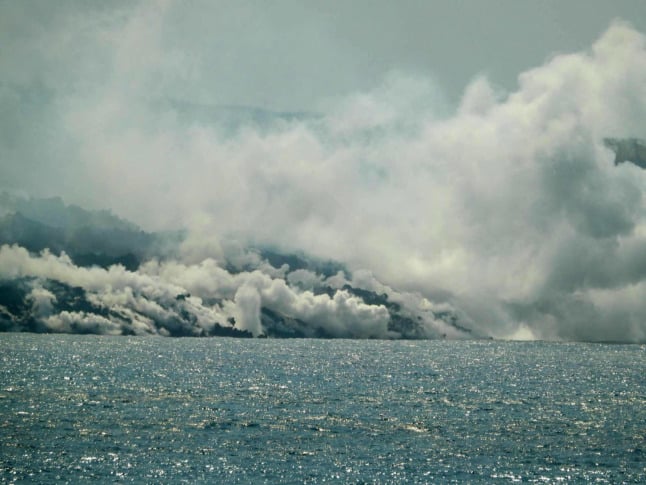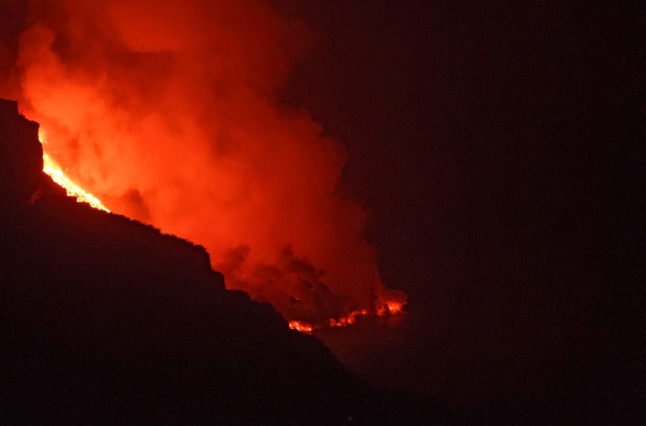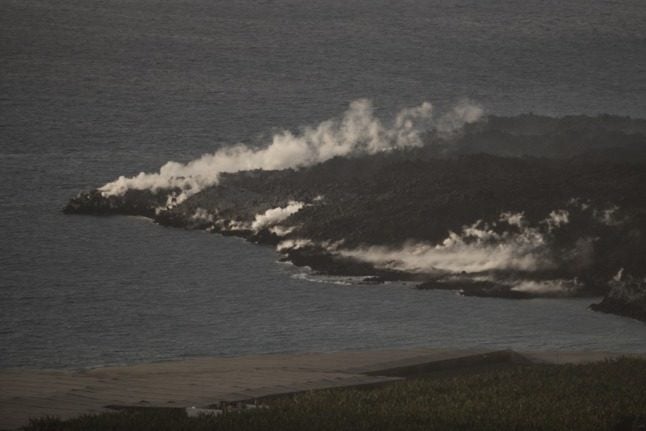“There’s nothing beautiful about it,” grumbled Jose Carlos Bautista Martin, a pensioner of 70 who looked on agog with fellow villagers as the volcano continued to spew waves of hot lava into the air.
“All it leaves behind is black, dark lava and an intense blaze which looks as if it will go on forever, growling as if it were the very devil himself,” he adds of the aeroplane-like cacophony accompanying an eruption which has wrought havoc and forced thousands from their homes.
Tazacorte port offers a perfect vantage point for spying the mouth of the volcano which dominates the island, a popular holiday destination, as well as the heaps of ash and lava cascading down to the sea hundreds of metres below its peak.
Even by Thursday, experts estimated the debris had covered an area bigger than 25 football pitches, with concerns rising over worsening air quality in nearby residential areas since the eruption began on September 19th, the volcano sending tongues of molten rock flowing out of its main cone.
READ ALSO: Lava from La Palma’s volcanic eruption already covers more than 100,000 sqm of sea

Despite the damage to countless homes and businesses, local people are coming together to show each other solidarity in a time of crisis.
Down in the port, fisherman Jesus Guillermo Hernandez Rodriguez, 49, defiantly hoses away sticky blackened volcanic sand which has covered his vessel.
“It is a daily job, maintaining the boats,” sighs Rodriguez, rubbing his white beard in frustration with weatherbeaten hands.
Even if he still tries to manage a minimum catch, most of what he does pick up “is not edible because of the sand,” the dark gunk sticking to what he does land.
What future?
Hernandez normally lands a catch worth around 3,000 euros a month which he shares with a colleague but this past fortnight is a virtual write-off and he expects more of the same for now as he worries about the cost.
He explains he operates in what is “one of the best fishing zones in the west of the island”.
But now it is covered with molten rock.
The area had already been reeling from the effects of the coronavirus, and Tazacorte was just keeping itself economically afloat when the eruption, the first on La Palma since 1971, hit.
Everybody in the village knows somebody who has suffered material loss, from houses engulfed in lava, to their job in a fishing industry left all but paralysed, the same fate befalling those working in agriculture or tourism.
“My son comes back home at night and tells me, ‘mum, yet another day I haven’t worked as we didn’t have a single table'” to serve, Nieves Acosta, 56, says of her son, a waiter in a restaurant.
“You talk about the future — but what future is there?,” she sobs.
“If there is no fishing then agriculture is hit, more than hit. What will become of our children?”
Rain of ash
The eruption brought dozens of journalists and scientists to rake over the island but their excited curiosity is in stark contrast to the serious and lined faces of locals.
“Here, people were happy but now they are hanging their heads,” says Cristina Sanchez, who lives in the nearby commune of Los Llanos de Aridane.
The “rain of ash” from the volcano “is driving me insane,” says Nieves, who works at a retirement home and who is taking a break over a coffee with Jesus, a friend who has just lost his job at a banana export firm.
Massive swathes of banana plantations dominate the scenery in Tazacorte — exports of the fruit are one of La Palma’s main earners.
Nieves, who refuses to give her surname, says she has little hope for the future after the volcano “destroyed everything.”
She says she just hopes that “when it’s all over people will come, that they will all come” and help put the shattered community back together again.
READ ALSO:
- Which Palma? How to tell the difference between the places in Spain called Palma
- How often do volcanic eruptions happen in Spain and the Canary Islands?
Since it began on September 19, the dramatic eruption of Cumbre Vieja has forced thousands out of their homes, while lava has destroyed hundreds of houses, businesses and huge swathes of banana plantations. (Photo by Sunsets Sweden / AFP)



 Please whitelist us to continue reading.
Please whitelist us to continue reading.
Member comments